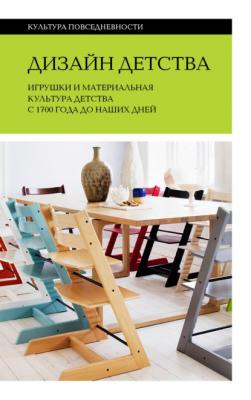Дизайн детства. Игрушки и материальная культура детства с 1700 года до наших дней. Коллектив авторов
Читать онлайн.| Название | Дизайн детства. Игрушки и материальная культура детства с 1700 года до наших дней |
|---|---|
| Автор произведения | Коллектив авторов |
| Жанр | История |
| Серия | Культура повседневности |
| Издательство | История |
| Год выпуска | 2018 |
| isbn | 978-5-4448-1629-5 |
16
Локк предложил нанести на кубики буквы алфавита.
17
Brewer J. Childhood Revisited. P. 35–36; Brewer J. Educational Toys in America: 1800 to the Present / ed. by Karen Hewitt and Louise Roomet. Burlington: The Robert Hull Fleming Museum/University of Vermont, 1979. P. 38; Plumb J. The New World of Children in Eighteenth-Century England // The Birth of a Consumer Society: The Commercialization of Eighteenth-Century England / ed. by Neil McKendrick, John Brewer, and J. H. Plumb. Bloomington: Indiana University Press, 1985. P. 286–315.
18
Calvert K. Children in the House. P. 7. Цит. по: Калверт К. Указ. соч. С. 14.
19
Ibid. P. 27–38; Kevill-Davies S. The Wide World // Kid-Size: The Material World of Childhood, Alexander von Vegesack, foreword. Milan: Skira Editore/Vitra Design Museum, 1997. P. 51–54.
20
Ottlinger E. Children’s Furniture, Nurseries and an Imperial Childhood // Fidgety Philip! A Design History of Children’s Furniture / ed. by Eva B. Ottlinger. Vienna: Böhlau, 2006. P. 25–33.
21
Boehn M. Puppen und Puppenspiele. München: Bruckmann, 1929. Коллекционер и историк искусства Констанс Эйлин Кинг оспаривала положение Бёна о том, что у кукол в древнем мире были преимущественно культовые функции. И хотя она соглашалась с ним в том, что главная и самая древняя функция кукол – это поклонение, Кинг все же настаивала, что дети, подчиняясь естественному стремлению подражать взрослым, делали собственных кукол, наподобие взрослых идолов. Кинг предполагала, что существовали куклы низшего порядка, которых, по-видимому, делали родители или сами дети, копируя религиозных идолов (King C. Dolls and Dolls’ Houses. N.Y.: Hamlyn, 1977). – Примеч. автора.
22
Cross G. Kids’ Stuff: Toys and the Changing Worlds of American Childhood. Cambridge: Harvard University Press, 1997. P. 14.
23
Rogers M. Barbie Culture. L.: Sage, 1999; Rand E. Barbie’s Queer Accessories. Durham and L.: Duke University Press, 1995.
24
Peers J. Adelaide Huret and the Nineteenth-Century French Fashion Doll: Constructing Dolls/Constructing the Modern // Dolls Studies: The Many Meanings of Girls Toys and Play / ed. by Miriam Forman-Brunell and Jennifer Dawn Whitney. N. Y.: Peter Lang, 2015. P. 171.
25
Fleming D. Powerplay: Toys as Popular Culture. Manchester: Manchester University Press, 1995. P. 42.
26
Forman-Brunell M. Interrogating the Meanings of Dolls: New Directions in Doll Studies // Girlhood Studies. 2012. No. 1 (5). P. 3–13. Также см.: Rand E. Barbie’s Queer Accessories; Chin E. Ethnically Correct Dolls: Toying with the Race Industry // American Anthropologist. 1999. No. 2 (101). P. 305–321; Chin E. Purchasing Power: Black Kids and American Consumer Culture. Minneapolis: University of Minnesota Press, 2001; duCille A. Black Barbie and the Deep Play of Difference // The Feminism and Visual Culture Reader / ed. by Amelia Jones. L.: Routledge, 2003. P. 337–348; duCille A. Dyes and Dolls: Multicultural Barbie and the Merchandising of Difference // Differences: A Journal of Feminist Cultural Studies. 1994. No. 4 (6). P. 46–68; Inness S. Anti-Barbies: The American Girls Collection and Political Ideologies // Delinquents and Debutantes: Twentieth-Century American Girls’ Cultures / ed. by Sherrie Inness. N. Y.: New York University Press, 1998. P. 164–183. Работа Мириам Форман-Брунелл частично повлияла на новое поле феминистских исследований куклы. Ее работа 1998 года Made to Play Home поставила под вопрос распространенное убеждение в том, что девочки рабски придерживались той формы игры с куклой, какую предписывали патриархальные гендерные идеалы. См.: Forman-Brunell M. Made to Play House: Dolls and the Commercialization of American Girlhood, 1830–1930. Baltimore, MD: Johns Hopkins University Press, 1998.
27
Lindencrona B. Dollhouses and Miniatures in Sweden // Swedish Wooden Toys / ed. by Amy Ogata and Susan Weber. New Haven: Yale University Press, 2014. P. 187–215.
28
Шкаф, горка, в котором стояли куклы и другие игрушки.
29
Broomhall S. Imagined Domesticities in Early Modern Dutch Dollhouses // Parergon. 2007. No. 2 (24). P. 52.
30
Lindencrona B. Dollhouses and Miniatures in Sweden. P. 188.
31
Broomhall S. Imagined Domesticities. P. 55.
32
Wilckens von L. Mansions in Miniature: Four Centuries of Dolls’ Houses. N. Y.: Viking Press, 1980. P. 57.
33
Jaffé D. The History of Toys: From Spinning Tops to Robots. L.: Sutton Publishing, 2006. P. 158–159.
34
Jacobs F. G. A History of Dolls’ Houses. N. Y.: Charles Scribner’s Sons, 1965. P. 28; Müller H. Ein Idealhaushalt im Miniaturformat: Die Nürnberger Puppenhäuser des 17. Jahrhunderts. Nürnberg: Verlag des Germanischen Nationalmuseums, 2006. P. 19–23.
35
Cook D. The Commodification of Childhood: The Children’s Clothing Industry and the Rise of the Child Consumer. Durham: Duke University Press, 2004; Pugh A. Longing and Belonging: Parents, Children, and Consumer Culture. Berkeley: University of California Press, 2009.
36
Seiter E. Sold Separately: Parents and Children in Consumer Culture. New Brunswick: Rutgers University Press, 1993. P. 66.
37
Zelizer
